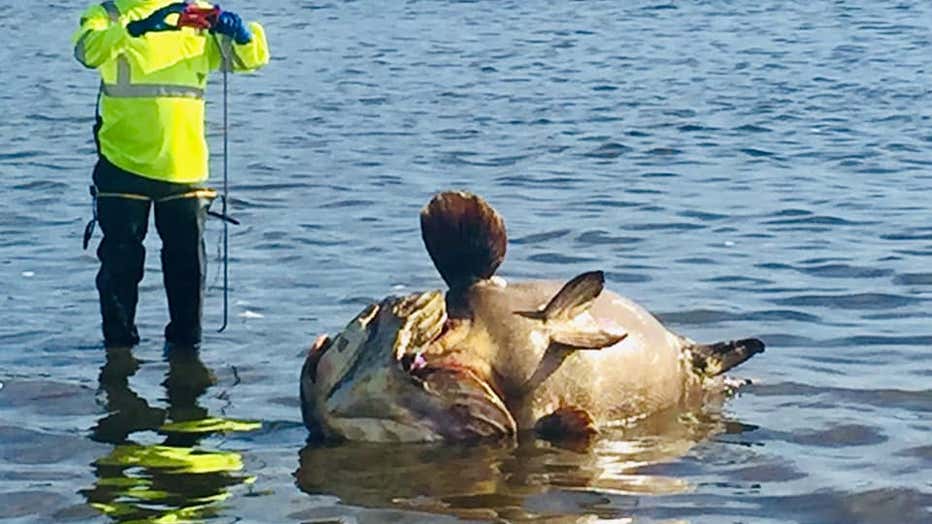St. Pete mayor calls for state help during emergency meeting on red tide
ST. PETERSBURG, Fla. - For days, crews in St. Petersburg have been struggling to clean up miles and miles of dead fish off the coast making city resources overwhelmed and stretched thin. Thursday, city council members will meet to address the ongoing red tide emergency that's sending tons of dead fish onto Tampa Bay shorelines. Marine scientists say the longer it goes on, the worse it can get.
LINK: Check beach conditions near you.
On Wednesday, Mayor Rick Kriseman also called on Governor Ron Desantis to declare a state of emergency. The move would free up more money and shrimp boats to deal with the massive fish kill. As of Thursday morning, nearly 800 tons of dead fish have been removed in St. Pete; 142 tons were collected on June 14.
Kriseman said 200 employees are working 12-hour days, 7 days a week, to remove the dead fish. The city of St. Petersburg has spent $350,000 on overtime and $700,000 for the overall effort. That's $61,000 per day.

Red tide devastates fish populations around Tampa Bay
The mayor of St. Pete is calling on Florida's governor to help address the red tide emergency along the city's shores as city employees work daily to remove large amounts of dead fish. So far, the city has collected about 500 tons of dead sea life.
"Please, Pinellas County, St. Petersburg, we need your help," Krisemans said. "This isn't about politics. I know the governor has had a lot to juggle lately, but we need his office to be paying attention to this."
Hours after the plea, the governor’s office slammed Kriseman’s comments, saying they are helping and there is no need for a state of emergency because they recently created a fund through the Department of Environmental Protection to deal with the crisis.
MORE: Dead groupers appear along St. Pete coast as city experiences massive fish kill

Credit: Wendy Wesley
The agency has already given out hundreds of thousands of dollars to Bay Area communities, state officials say.
"We're going to ignore the politics from the governor's office and continue to work with other state officials and county officials to get these fish out of the water," Kriseman tweeted Thursday morning.
The city says it is all hands on deck. They have staff members from every department: sanitation, parks and recreation, public works, police and fire rescue. They've spent well into the six figures to remove the fish.

Dead manta ray spotted among fish kill
The view from SkyFOX showed a large manta ray floating dead in Tampa Bay off the Bahama Shores area of southern Pinellas County.
READ: St. Petersburg ‘floating classroom’ offers educational cruise around Tampa Bay
The problem is more dead fish is turning up every day, and marine scientists with the University of South Florida said there’s no way to tell when it will end.
They said a combination of factors stirred up the water in the bay and made the fish kills more severe. They said it’ll likely have a long-term impact on local areas since most of the fish dying off live near the coast and don’t migrate.

Manatees spotted swimming through red tide in Tampa Bay
A group of manatees appeared in Tampa Bay off of St. Petersburg as red tide continues to plague the city, and the stench and dead fish overwhelms locals.
RELATED: Dead fish cause stink in St. Pete neighborhood after Elsa passes through
"Mostly what I've seen is primarily mullet and smaller fish, hardhead catfish, which is an oceanic catfish," explained Steven Murawski, a USF College of Marine Science professor. "We've also seen things like Goliath grouper, young Goliath grouper, which is, you know, it's an animal, could be tremendously large size, but they're juveniles. They occupy the mangroves in the lower bay."
Scientists said red tide is a natural process that forms offshore in the Gulf of Mexico before floating closer to land, resulting in fish kills. So, the algae can’t be killed off. But they said people can help by adding less nitrogen to the water. Fertilizers, industrial run-off, and stormwater overflows are known to fuel algae blooms.
The St. Pete city council meeting is set for 3 p.m. Thursday.


